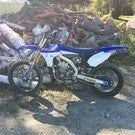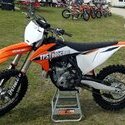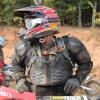Search the Community
Showing results for tags 'tools'.
-
So I'm about to check my valve clearances for the first time and I was wondering if feeler gauges go bad. meaning mine have some discoloration. they feel smooth to me but with such small tolerances, could that discoloration mean the feeler gauges are thicker than they should be? they aren't outright rusty, and they have a film of oil on them likely put there agaes ago by my father (they have been sitting unused in a tool box since he passed away. I haven't needed them until now since I last used them 30 years ago for my last four stroke ike's valve adjustment). I'm just wondering if these are still going to be good or if I should go ahead and get new ones at autozone. thanks!
-
Hey. I just got a 94rmx with a complete rm makeover, but I don't have the tools to fix it yet so I've not ridden yet. I was wondering if anyone has tips about riding. And if anyone has some spare tool they could give a beginner. I'm pretty poor so could be some time till I get them myself. The pics my beaut
-
is there any other electronic tools out there you can get to connect to your bike to see the hours? I know there are some tools out but I don't wanna spend the 200 - 400 on them. Im really just curious as to hours especially when you have a used bike. I know there are some tools you can download for free for cars on an phone and you just need a special connector and blue tooth to it.
-
Hello fellow thumpers, I am getting a new trail bike and It's time for me to invest in some nice tools. I've always purchased whatever is cheapest and It's time to change that. Also, what specific tools would you buy. Brand? I want them to last so I dont mind spending extra cash.
-
Hey i just put in a Jd jet kit and used the blue needle in the middle position with the 25 and 155 jets. I just need to adjust the fuel air mixture with the screw. I just don't know how to reach it and was wondering what people use to manipulate it. I obv. don't want to have to pull the whole carb out if I can help it. Thanks. Edit: The bike is a 2008 drz400sm with a stock carb that I just rejected. The bike start but the throttle is sticking. As in I can turn the throttle and let it go, and it will stay there. I still need to adjust the fuel screw but don't want to take the carb out. Is there a tool that can reach up and adjust the fuel screw at a 90 degree angle?
- 2 replies
-
- Jdjetkithelp
- drz400
-
(and 8 more)
Tagged with:
-
dropped the bike doing a dirt donut, Pretty sure I broke a pin on the change drum /gear holder star thing (and 1 week from my Friday the 13th DMV test that I need this bike for) but found a pin in the oil pan when I was trying removing the gear changer face plate. couldn't remove the plate because I realized you need to get the chain and sprocket out of the way since I don't have tools for either of those things I was wondering if I could get away with EITHER removing the sprocket OR the chain ...to save money. if not I guess ill just have to buy $400 impact wrench + a $200 master link revet tool.
- 6 replies
-
- gear
- transmission
- (and 5 more)
-
Who makes a good accurate small (covers 10-40 Nm) torque wrench these days? Mine is worn out, time for a new one so I'm curious who's got the best offering these days.
-
As we wrap up our final post on precision measuring for the at-home mechanic, I hope you have found this three part series on measuring helpful and informative. If you need a brush up or haven't gotten a chance to read Part 1 or Part 2, we compiled all three parts into a free guide for you. You can download your free copy by clicking here. This three part series comes right out of the book I published, The Four Stroke Dirt Bike Engine Building Handbook. I think you're going to love the in-depth knowledge and information provided in this book on four stroke dirt bike engine building. To learn more and order your copy click here. In this post I will be covering the final six precision measurement tools you have at your disposal. Each measurement tool in this post features a description of appropriate applications for the tool and a step-by-step tutorial on how to use it. This post is designed as a reference so that you can easily come back to it at any time as you become more comfortable using measurement tools during a rebuild. PLASTIGAUGE Plastigauge is one of the only measurement tools you won’t mind throwing away once you are done using it. Plastigauge is a measurement tool used to check the clearance between parts. The plastigauge consists of little strips of plastic which are inserted between two parts. Once assembled the plastic strip is compressed. The amount the strip compresses can be measured and correlated to a chart (supplied with the plastigauge) which defines the clearance for the measured compressed width of the strip. For engine building purposes plastigauge is ideal for checking clearances between engine components utilizing plain bearings. The plastigauge is a great tool for confirming clearance and measurements. Another plus is that unlike most other measuring tools, plastigauge is cheap! Plastigauge is usually sold in an assortment of sizes which cover multiple clearance ranges. Plastigauge strips will come in different diameters and each diameter will be capable of measuring a certain clearance range. Where to Use: Examples include cam to cam journal clearance, crank bearing to crankshaft journal clearance, and crank pin to rod bearing clearance. Calibrating Plastigauge Finally a measurement tool where no calibration is necessary. Just make sure you choose the appropriate size strip for your application. Also make sure the plastigauge is fairly new. Plastigauge does get old after awhile and using old plastigauge may not yield accurate results. Reading Plastigauge After the plastigauge has been compressed use a calipers to measure the width of the compressed strip. Record the width in your notebook. Then look at the clearance chart provided with the plastigauge to determine the clearance that corresponds to the measured width. Yes, it really is that simple. How To Use 1. Clean the parts being assembled 2. Insert a small strip of plastigauge between the parts being assembled. 3. Carefully lower the mating part down onto the plastigauge. Take great care to lower the part straight down so the plastigauge doesn’t move. 4. Install the fasteners used to secure the parts together. 5. Tighten the fasteners to the torque value recommended by the manufacturer. Follow any special tightening patterns that may apply 6. Carefully loosen the mated parts. Again, follow any special instructions for loosening provided by the manufacturer. 7. Remove the part. Check to see which part, if any, the plastigauge has stuck to. 8. Use a calipers to carefully measure the width of the plastigauge. 9. Refer to the chart provided with the plastigauge to determine the clearance which corresponds to the measured strip width. Tip: With a keen eye taper and out-of-roundness can also be spotted by using plastigauge. Keep an eye out for variations in strip width after it has been compressed for clues about the condition of the bore. DIAL INDICATOR A dial indicator measures variations in height by utilizing a plunger which travels up and down. As the plunger travels a dial gauge records the amount the plunger has moved. For engine building purposes a dial indicator is a handy tool to have when measuring valve lift and finding top dead center. There are a wide range of dial indicators on the market. Choosing the best one for engine building may be daunting if you’re not familiar with them. There are two main features you want to look for when selecting an indicator. The amount of travel the indicator has and the resolution of the indicator. Choose an indicator with around 1.0” (25mm) of travel which has a resolution of 0.001” (0.025mm). This type of indicator will work well for engine applications. In addition to the indicator getting a few accessories for the indicator will be beneficial. Most indicators are not sold with a base. Magnetic bases are really handy when setting the indicator up and provide a means of securing the indicator so it can’t move. Even when working with aluminum parts (ex. cylinder head) a magnetic base can be utilized by bolting a flat piece of steel to the aluminum part. Dial indicators usually come equipped with rounded contact points which are ideal for measuring flat surfaces. Occasionally you may encounter a setup which requires a different contact point. A variety of contact points are offered for indicators and having an assortment never hurts. Tip extensions are a must have if you plan on doing any deep depth work with the indicator. One situation which routinely requires a tip extension is when using the indicator to find top dead center of the piston. Tip extensions can be bought in multiple lengths. Where to use: Examples include measuring valve lift, and finding top dead center. Reading Dial Indicators Reading a dial indicator is very similar to reading a dial calipers. The only difference is the dial indicator’s gauge face is equipped with a second smaller dial face. For an indicator with a resolution of 0.001” the small face is divided into 10 graduations. Each graduation represents a tenth of an inch. The outer dial face is divided into thousandths of an inch. Each time the outer needle rotates one revolution around, the second small needle tallies a tenth of an inch. This eliminates the need for the user to keep track of how many times the needle has gone around. The total measurement is comprised of the number of tenths of an inch the smaller needle is indicating plus the number of thousandths the large needle is indicating. In the picture above the dial indicator reads _0.136". For metric and other resolutions of dial indicators the reading process is identical to the above. Take note of the units and resolution and proceed to read the indicator accordingly. Calibrating Dial Indicators Checking and adjusting the accuracy of dial indicators usually can’t be done easily in one’s own shop. For dial indicator calibration the indicator would have to be sent to a calibration lab. Fortunately, the applications an indicator is used for when building engines doesn’t require the utmost accuracy so calibration is seldom a problem. How To Use: 1. Clean the contact point of the indicator and the part which will be indicated. 2. Carefully set the indicator up so that it is fixed to a sturdy base which can’t move. 3. The amount of travel in each direction you will need depends on the specific application you are measuring. Consider the motion and travel of the part you want to measure and set the indicator accordingly so that it doesn’t run out of travel halfway through measuring. For example, when measuring valve lift you would want to engage the indicator so that around a quarter of the plungers travel has been used. 4. Square the spindle of the indicator being measured. The more square the indicator spindle is to the part the more accurate the readings will be. If the indicator is set at an angle to the direction of travel of the part the indicator will not read accurately. Keep this in mind and always try to set the indicator spindle as square as possible to the part being measured. 5. Zero the indicator by rotating the gauge face so the outer needle aligns with “0”. For example when measuring valve lift the zero point would be when the valve is fully closed. When checking runout the zero point may be a low or high point. 6. Move the part being indicated a few times returning it to its starting position each time. Check to make sure the indicator consistently reads “0”. If it doesn’t then carefully adjust the gauge face to realign the needle. 7. Once the indicator has been zeroed proceed to move the part being indicated and take measurements. 8. After measuring return the part to its original position. Occasionally an indicator can get bumped or something can happen during the procedure. This is a good way to confirm one last time that the indicator is still zeroed. DIAL TEST INDICATORS Dial test indicators are very similar to dial indicators, however their primary function is more as a comparative tool than a measurement tool. The main difference between a dial indicator and dial test indicator is the dial test indicator uses a contact point which pivots instead of a plunger that travels up and down. This pivoting action results in an arcing path instead of a straight up and down path. The test indicator is best suited for taking comparative measurements and zeroing runout. For engine building purposes this makes a pair of dial test indicators well suited for measuring the runout of a crankshaft. Just like dial indicators, test indicators are made with different lengths of travel and different resolutions. The most suitable resolution for crankshaft truing and inspection purposes is 0.0001” (0.0025mm). Most test indicators with a resolution of 0.0001” will have a travel of 0.008” (0.203mm) or 0.010” (0.254mm) which will be suitable for crankshaft inspection. The test indicators will require fixturing so having a pair of bases, stands, and clamps is necessary. Fortunately, the test indicators use similar mounting systems as dial indicators so if you have fixturing for dial indicators you are all set to mount the test indicators. Where to use: Examples include crankshaft inspecting or truing. Reading Dial Test Indicators The gauge face of a dial test indicator is symmetrical. The face is divided into graduations based on the resolution of the test indicator. Each side of the face represents half of the total travel of the test indicator. Reading the gauge is simply a matter of determining how many graduations the needle has moved from its starting point to its ending point. Calibrating Dial Test Indicators Like dial indicators, calibrating dial test indicators is usually done by a professional calibration lab. As long as the test indicator is well cared for the need for calibration should be infrequent. How To Use: Since the contact point of the test indicator travels in an arc the way the indicator is set up has an impact on measurement. This is the main reason test indicators can’t be relied on heavily for taking measurements and instead are used for comparing. 1. Clean the contact point of the indicator and the part which will be indicated. 2. Carefully set the indicator up so that it is fixed to a sturdy base which cannot move. 3. Most test indicators function best when the contact point is perpendicular to the direction of travel of the work piece. Some indicators differ slightly and should be set at a slight angle, so confirm with the instructions supplied with your test indicator to attain the correct orientation. 4. The majority of test indicators work best when the contact point is preloaded. As a rule of thumb a 1/10 - ¼ revolution of the needle is about right for setting preload. Instructions supplied with individual indicators may have specific preload instructions. 4. Rotate the part to find the high or low point. Zero the indicator by rotating the dial face so the needle aligns with “0”. 5. Move the part being indicated a few times returning it to its starting position each time. Check to make sure the indicator consistently reads “0”. If it doesn’t then carefully adjust the gauge face to realign the needle. 6. Once the indicator has been zeroed proceed to move the part being indicated and take measurements. 7. After measuring return the part to its original position. Occasionally an indicator can get bumped or something can happen during the procedure and this is a good way to confirm one last time that the indicator is still zeroed. TRANSFER GAUGES Transfer gauges are measurement tools which don’t yield a direct measurement. They are simply tools which can be used to transfer the dimensions of something requiring measurement to a measurement tool. There are two types of transfer measurement tools commonly used in engine building, small hole gauges and telescoping gauges. Transfer gauges can be tricky to use accurately for a couple reasons. First, they introduce a second source for error. Instead of taking a direct measurement the measured part must first be sized using a transfer gauge. Then the gauge must be measured by a measurement tool such as a micrometer. It is easy to see how mistakes can accrue in this situation. Second, transfer gauges rely heavily on feel to obtain accurate measurements. If the user of the gauge is unskilled, the transfer measurements could be all over the board. Taking these points into consideration transfer gauges can still be incredibly helpful when measuring engine parts. Transfer gauges are one of the most relied on methods of accurately measuring internal diameters. SMALL HOLE GAUGES Small hole gauges are used to transfer internal measurements usually less than ½” in diameter. A small hole gauge has a split in its head which allows the head to expand or contract to the size of the part being measured. An adjustment knob at the end of the handle is turned to expand or contract the head. The head on the gauge can either be a full or half sphere design. The half sphere designs have the advantage of being able to measure blind holes. Small hole gauges are usually sold in sets capable of measuring from around 0.125 - 0.500” (3.175 - 12.4mm). Each set is comprised of around four gauges with each gauge being able to measure a certain portion of the set’s total range. For engine building purposes, small hole gauges are primarily used to measure the inner diameters of valve guides. Where to use: Valve guides How to use: 1. Clean the bore of the part to be measured and the head of the small hole gauge. 2. Slowly turn the adjustment knob on the gauge expanding the head of the gauge inside the bore of the part being measured. 3. Simultaneously, gently rock the gauge back and forth and fore and aft inside the bore until the head of the gauge just starts to drag on the bore of the part. As you rock back and forth make sure the handle of the gauge passes through the point where the handle is square to the bore. 4. Remove the gauge. 5.Use a micrometer to measure the diameter of the gauge to determine the diameter of the part’s bore. Since the gauge can easily be compressed little to no pressure can be applied by the measuring faces of the micrometer. 6. Slide the gauge back and forth and fore and aft as you delicately tighten the ratchet or thimble of the micrometer. An accurate reading will be obtained when the micrometer just starts to drag against the gauge. Remember to measure perpendicular to the split in the gauge. 7. Lock the the spindle of the micrometer and read the micrometer to obtain the bore diameter. Hot Tip: Since this is partly an exercise of feel, take multiple measurements until the measurements start to yield the same results. This way you can be certain the measurements are accurate. TELESCOPING GAUGES Telescoping gauges are the big brothers of the small hole bore gauges. Telescoping gauges are shaped like a “T”. A tightening knob is situated at the handle end and it controls one or two spring loaded plungers (dependent on gauge type). Once the knob is loosened the plunger(s) expand outwards to capture the diameter of the bore being measured. The plunger ends are convex so the gauge can be rocked back forth to obtain the measurement. Telescoping gauges are usually sold in sets capable of measuring from around 0.3125 - 6.0” (8 - 152.4mm). Each set is comprised of around six gauges with each gauge being able to measure a certain portion of the set’s total range. Where to use: Examples include lifter bucket bore and cylinder bore. How to use: 1. Clean the bore of the part to be measured and the ends of the plungers on the telescoping gauge. 2. Set the gauge inside the bore with one plunger touching the side of the bore. 3. Slowly loosen the adjustment knob on the gauge handle expanding the plungers of the gauge inside the bore of the part being measured. /index.php?app=core&module=attach§ion=attach&attach_rel_module=post&attach_id=231329 4. Set the gauge up so that the handle is just out of square with the bore. 5. Tighten the adjustment knob down. 6. Gently wiggle the gauge back and forth while passing the gauge through the bore. Only pass the gauge through the bore once. This will center the gauge and set the plungers to the diameter of the bore. /index.php?app=core&module=attach§ion=attach&attach_rel_module=post&attach_id=231330 7. Clean both measuring faces. 8. Use a micrometer to measure the diameter of the gauge to determine the diameter of the part’s bore. Since the gauge can be compressed, little to no pressure can be applied by the measuring faces of the micrometer. 9. Slide the gauge back and forth and fore and aft as you delicately tighten the ratchet or thimble of the micrometer. An accurate reading will be obtained when the micrometer just starts to drag against the gauge. [series of pics showing measurement direction 10. Lock the the spindle of the micrometer and read the micrometer to obtain the bore diameter. Hot Tip: Since this is partly an exercise of feel, take multiple measurements until the measurements start to yield the same results. This way you can be certain the measurements are accurate. V-BLOCKS A V-block is a large precision machined metal block with a V in it. During an engine build V-blocks are used primarily for checking runout of cylindrical parts such as the crankshaft. /index.php?app=core&module=attach§ion=attach&attach_rel_module=post&attach_id=231331 When shopping for V-blocks a precision ground matched set should be purchased. Fancy versions may come with magnetic bases, multiple Vs, clamps, or rollers. While some of these features are nice they certainly aren’t necessary and add to the cost. That wraps up our three part series on precision measuring for the at-home mechanic, thanks so much for reading! If you would like all this precision measuring information in one place so you can come back and easily reference it, we created a free guide for the ThumperTalk community that you can download right to your computer or phone. Click here and I'll email the The At-Home Mechanic's Guide To Precision Measurement right to you so you can have it organized in one place. If you are interested in owning a copy of The Four Stroke Dirt Bike Engine Handbook, you can learn more by clicking here. Thanks again for reading and feel free to leave a comment below! -Paul Olesen DIY Moto Fix | Empowering And Educating Riders From Garage To Trail.
-
I rode the Durty Dabber's Dual sport this weekend. It was in Lock Haven, PA and over 500 riders showed up. Since it was in PA, there were lots of rocks. In the riders instructions, the organizers talked about pinch flats, how to avoid them, pressure values to run. They even had a very nice compressor/gauge setup next to registration so you could adjust your pressures. Even with that, I must of passed at least a dozen bikes lying on their side with a group of riders changing (or fixing) their flat tube. I've changed a lot of tires over the years, but never on the side of a muddy mountain. I have tools, air compressor, and probably more important, a nice bike stand/lift. What are the tricks to do it in the mud? As I think about it a bit, I have more questions than answers: How do you break the bead? How do you find the leak in the tube? Is there a trick to getting the axle out when its pointing into the ground? how do you get gas to not flow out of the tank/carb when the bike is on its side? How do you get the tire/wheel aligned so the disk brake pads are out of the way when you are putting it back on? How do you keep mud out of the nice clean new tube? etc?
- 4 replies
-
- dualsport
- tuberepair
-
(and 2 more)
Tagged with:
-
The first year I owned my 250L, I gooned around in supermoto trim 100% of the time. If I wanted to ride off-road I would trailer my dirt bike since there are no extensive public trails within 1 hour of my home. 6 months ago I wore out my street supermoto tires again. Got busy, never ordered replacements so I swapped over to the stock wheels and tires. I started venturing further out to do more off-road. This eventually led to rim locks, better tires, skid plate, full RaceTech suspension and some supplemental luggage. The luggage I've been carrying is basic. Wolfman enduro tank bag, Wolfman fender bag, Wolfman bottle holder with 1L of extra fuel. I also ride with an off brand CamelBak. I carry basic tools, 1 spare tube and 2 spoons, phone, charger, air pressure guage, bike pump, zip ties, GoPro stuff. I'm getting bored of the local riding area and I want to start taking full day trips. I ride alone most of the time, I probably prefer it even. My questions: What is your must have gear for day trips that might also fit in my current bare bones luggage? I don't want more bags. I don't have rain gear except for my tank bag. I figure if it's calling for rain I'm not going and if it rains late in the day, I'm headed home. Bad idea? Do any of you trailer your bike to get closer to the action? Most of the riding I want to do is in the mountains of NC. I'm about 1.5-2 hours east of the roads I'm trying to get to. That's an extra 3+ hours of riding to get to the good spots and get home! What do you use for GPS? I use google maps on my phone typically. However I don't expect to have service in some locations. Does anyone use a device like the Garmin InReach? My wife would prefer I get one of those since I ride alone and will be on remote forest roads. Thanks for the advice.
-
Hey guys, Im new to the LA, West LA area, I have minimal tools, street bike is my only form of transportation and the fork seals are puking oil. I am looking to rent a front fork seal tool off someone in the local area, or do the seals in someones shop, throw some cash or work for the use of the tool. I grew up on two wheels, i have lots of knowledge on off road and street bikes, will offer help for help. Whatever it takes, just trying to get these fork seals changed before they bomb out on my way to work. Thank you,
-
I've got a '93 S10. At the age of 16, I love this truck and it's perfect for me. Anyways, I wasn't willing to sacrifice the bed space to get a full size diamond plate toolbox. I need that space for my dirtbike. A full sized box would also cover my tow hooks on each corner, making me unable to strap anything down. So, I took a craftsman box that my teacher gave me and bolted it in the bed. It contains all the tools I'd need in an emergency with my truck. But I've been wondering, would this box survive a rainstorm or a season change? It's painted, but the paint is chipped in some spots. The tools are cheap tools, but I don't want them to become inoperable (ratchets and such) due to rust. What's you guys' thoughts? Let me know if you think it will survive, and if you don't think it will, tell me why. Thanks! Really interested to see what everyone thinks. I'm just unsure if this will work, but I'm hoping it will??
-
I'm considering buying a spoke torque wrench. I see they sell for about $90 on up, depending on brand and other voodoo. I've used the plink test to identify spokes that are too loose: gently ping a screwdriver against the spoke as you turn the wheel, should go ping at the same tone. But my focus was on having the wheel be true and round, not the torque on any given spoke. Are they a useful tool?
-
Was wondering if anyone knows where to get a good rear (or front) fender mounted gear bag big enough for a few tools and two water bottles (regular 16oz) thanks!
-
My two sons and I are proud owners of new a YZ250X, TTR125 and TTR110 and are anxious to get on them. I'm trying to sort out what tools and repair supplies we should be putting in the car and would appreciate any suggestions on the inventory list itself, or suggestions for any of the specific items on it. What I am pretty sure we need, but will need to buy... Spare tubes -- HD? -- for all 6 size rims Tire levers. How many? Will any do? Tire lever rim protectors? Two? Will any do? Spare spark plugs What I wonder if we need to get? Slime (put it in at the start)? Tools I own and plan to bring Metric socket set and open-end wrenches Hex wrench Various screwdrivers Various pliers Torque wrench Portable compressor Tire pressure gauge Miscellaneous Toolbox for the above Soap, bucket, brush Headlamp / flashlight Tape & zip ties Repair stand Camp chairs Anything that am I missing?
- 26 replies
-
- 1
-









